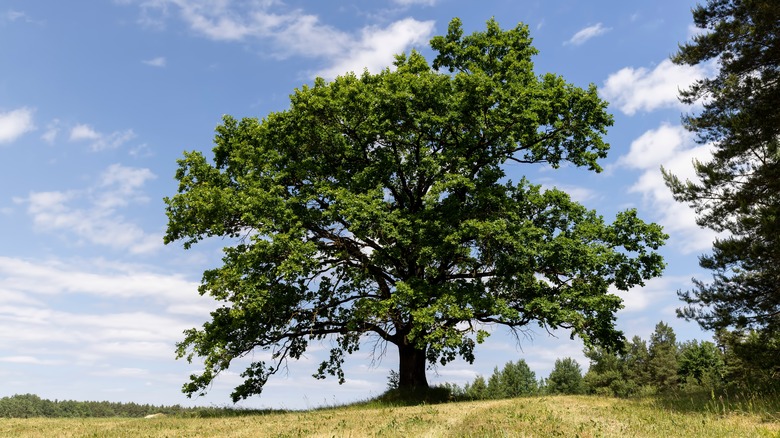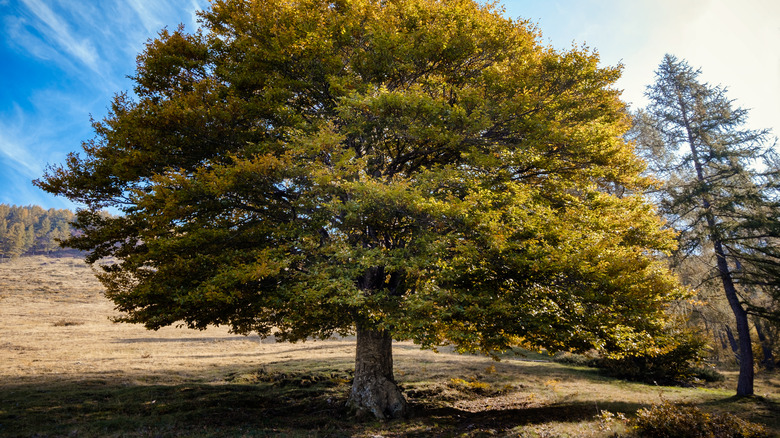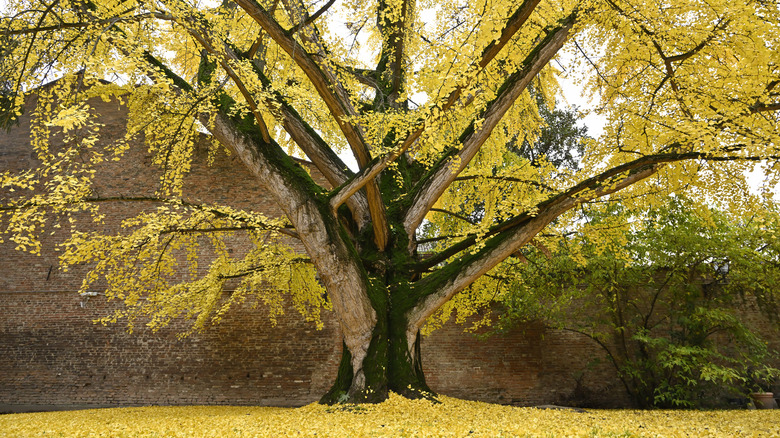Here's How Long It Takes These 14 Popular Trees To Grow
A yard without trees is like a cup of coffee without creamer — functional, sure, but missing some key element that makes its presence more enjoyable. Spending time outdoors is vital for good mental health, but studies have found that trees, specifically, have a profoundly positive impact on our well-being (via New York State Department of Environmental Conservation). Of course, beautiful trees won't just pop up in your yard overnight; they require some protection, nurturing, and, most of all, patience. Whether you're hoping to add a new tree to your space or just curious about when a young tree in your yard will reach its full potential, it can help to know how long it takes for a tree to grow. In general, softwood trees grow more quickly than hardwood trees, and most trees will take several years, if not decades, to reach their maximum height.
Knowing the average growth rate of popular trees is great for determining the age of an existing tree or predicting how long it will take for a young sapling to mature. If you're struggling to choose, this knowledge can also help you decide between slow-growing trees that will beautify your home for generations or fast-growing trees to shade in a hot sunny backyard. Check out the general growth speeds for these popular garden and landscaping trees, as well as other helpful notes about their overall growth patterns.
1. Oak
There are many different types of oak trees in the Quercus genus, but most are relatively slow-growing, taking between 20 and 50 years to reach full maturity. However, as long as they're alive, oaks can continue growing at a rate of about 1 to 2 feet per year in ideal conditions. Because they can live for centuries, many oaks will become quite large and impressive with time, but if you don't have the patience to wait so long, some faster-growing oak species include the northern red oak, nuttall oak, willow oak, and shumard oak.
2. Elm
From a distance, elm trees in the Ulmus genus can have a look that's quite similar to oak trees, but their leaves tend to show off more vibrant color throughout the seasons. Elm trees usually grow about 1 to 2 feet per year on average and reach maturity around 150 years, depending on the species. Unfortunately, elm tree growth can also be affected by Dutch elm disease, an aggressive fungal infection that causes branches to wilt and die. If you're looking for a fast-growing tree, the American elm is a good choice — this species can put on as much as 3 to 5 feet per year!
3. Magnolia
Magnolias are widely recognized for their giant saucer-like blooms, but the trees themselves can lend some impressive shade and foliage too. There are over 200 species in the Magnolia genus, but only a handful are commonly cultivated for landscaping. Overall, magnolia trees are relatively slow-growing, but can vary per species. The southern magnolia tree (Magnolia grandiflora) grows about 1 to 2 feet per year and can take 10 to 20 years to reach full maturity. Meanwhile, the star magnolia (Magnolia stellata) only grows around 6 inches to 1 foot per year on average.
4. American sycamore
American sycamores (Platanus occidentalis) are a great choice for areas that desperately need shade, but homeowners should be aware that these beautiful trees can grow rather huge — and fast. These deciduous trees grow around 2 feet per year. With growth that continues throughout their life and relatively long lifespans of over 250 years, you may soon have a behemoth tree in your yard where once their was a small sapling. These trees are often grown in large public parks, however, for yards with lots of space in USDA zones 5 to 8, an American sycamore can be a stunning landscape addition.
5. Eastern redbud
The eastern redbud (Cercis canadensis) is a very popular tree for gardens and landscapes, because of its bright seasonal colors and ability to attract pollinators. Depending on the variety, these trees can be more or less shrub-like, reaching a maximum height of 20 to 30 feet when mature. The eastern redbud will grow around 1 to 1.5 feet per year, but these eye-catching trees are somewhat short-lived. Most redbud trees will slow down, weaken, and eventually die after about 20 years, although some can live as long as 50 years.
6. Pines
If you've ever gazed up at a magnificent swaying pine tree, you might wonder, can you really grow a flourishing tree from a pinecone? Yes, but understand that a humble seed can quickly spring up into a huge pine! Evergreen and softwood, pine trees are some of the fastest growing trees. The eastern white pine (Pinus strobus) is rumored to gain up to 5 feet in a year, but most other pines average around 2 to 3 feet per year. Pine tree growth usually occurs fastest while the trees are young, then gradually slows with age.
7. Flowering dogwood
Flowering dogwood trees (Cornus florida) are another excellent choice for landscapes and gardens, adored for their charming white or pink blooms in spring and cozy red foliage in fall. They can also be an excellent choice for drawing bees into pollinator gardens. Dogwood trees have a somewhat slow growth rate of around 1 foot per year. These pretty and popular trees take about 10 years or so to reach maturity. At their fullest potential, dogwoods may grow to around 40 feet in height, depending on the specific type of dogwood tree you have.
8. Pecan
Pecan trees (Carya illinoensis) are a distinct type of hickory tree native to North America and commonly found in the southern states of Texas, Oklahoma, Louisiana, Georgia, Alabama and beyond. Most beloved for their tasty and nutritious nuts, pecan trees can also be grown in landscaping as shade trees. These deciduous trees can grow about 1 to 2 feet per year, and will continue growing until they cap out at around 100 feet tall. While they can live for over a hundred years, a pecan tree will reach full maturity at around 18 to 22 years old.
9. Crape myrtle
One of the most popular landscaping plants of all time, crape myrtles belong to the genus Lagerstroemia, which contains several deciduous trees and shrubs. Low-maintenance, affordable, and relatively fast-growing, crape myrtles are commonly seen in city and suburban landscapes, where they lend some fullness and shade coverage, but are most prized for their bright summer flowers. Crape myrtles grow very quickly, usually putting on over 2 feet per year until they reach a maximum height of around 15 to 25 feet. Unfortunately, crape myrtles have rather short lifespans, with most living fewer than 50 years.
10. Italian cypress
Unique and eye-catching, Italian cypress (Cupressus sempervirens) is a tall tree frequently used in landscaping, especially near hedge gardens and grand front entryways, where this evergreen tree will give you privacy year round. While they might not provide much shade, these elegant trees can spring up remarkably fast, gaining up to 3 feet per year. Italian cypress trees take about 50 years to fully mature, but can reach over 100 feet tall at their peak growth. In perfect conditions, these trees can live for hundreds of years, but most live to about 150.
11. Japanese maple
Stunning red leaves make the Japanese maple (Acer palmatum) a tempting pick for any landscape or gardening project. While they are breathtakingly beautiful, you'll have to be patient to enjoy the splendor of a fully grown Japanese maple. Japanese maples grow rather slowly, usually about 6 to 12 inches per year, but in perfect conditions some varieties may grow slightly faster, closer to 1 to 2 feet per year. Japanese maples rarely grow very tall; most take around 50 years to reach just 25 feet, but they can live for around 100 years.
12. River birch
River birch trees (Betula nigra) are a popular choice in landscaping, with pretty bark that peels back like paper and a tall canopy that provides decent shade. A river birch tree can also grow impressively fast, putting on between 1.5 and 3 feet each year. When river birches are fully mature, these trees can be about 60 to 80 feet tall, so planting one in your yard will take some spatial consideration. Of course, all this rapid growth comes at a cost, and most river birches will only live between 50 and 75 years.
13. Crabapple
Another beloved tree that's frequently used in gardens and landscaping, a crabapple tree from the genus Malus can draw in pollinators from miles around with its charming pink flowers. This tree exhibits a growth rate of about 1 to 2 feet per year, and after about 3 to 5 years of growth, the tree will begin to produce its iconic, tiny apple-like fruits. Although they only live between 40 and 60 years, crabapple trees can range anywhere between 6 and 30 feet tall when fully grown, depending on the specific type, so they can be a good choice for smaller yards.
14. Ginkgo
Gingko trees (Ginkgo biloba) display bright green leaves throughout spring and summer, which turn to a stunning golden yellow in fall. In general, gingko trees have a moderate growth of about 1 to 2 feet per year, but high carbon soil and good drainage can help the gingko tree grow faster. When fully matured, these trees have a maximum height of around 50 to 80 feet. It is usually only disease or disaster that causes these trees to die; many are thousands of years old, but in the right conditions, ginkgo trees can theoretically live forever.














